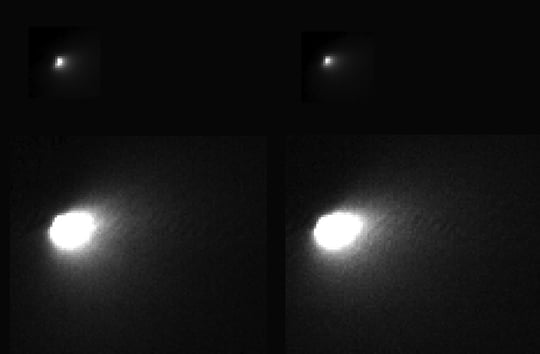This article is more than 1 year old
Comet Siding Spring revealed as flying molehill
Hiding from this space pimple isn't going to do humanity's reputation any good
The first images of Comet Siding Spring, a celestial body deemed so menacing that humanity cocooned its very best robots, has turned out to be rather smaller than imagined.
The first images of the comet, captured by the High Resolution Imaging Science Experiment (HiRISE) camera aboard NASA's Mars Reconnaissance Orbiter, suggest it's rather smaller than first supposed.
As NASA explains, the images are at a scale of “about 150 yards (138 metres) per pixel.”
“Telescopic observers had modeled the size of the nucleus as about half a mile, or one kilometer, wide,” NASA's post continues. “However, the best HiRISE images show only two to three pixels across the brightest feature, probably the nucleus, suggesting a size less than half that estimate.”
The image NASA has kindly provided for us to use below is a little confusing, as it is actually two compound images, taken nine minutes apart. The top row of pictures show what NASA describes as “full dynamic range, showing the nucleus and bright coma near the nucleus.” The bottom row shows “... versions where the fainter outer coma is brightened, saturating the inner region.”

Are you ready for your closeup, Comet Siding Spring?
Image:NASA/JPL-Caltech/University of Arizona
Don't be fooled by those big egg-shaped pics: the real comet is the little eight-bit smudge at the top and what you're seeing is probably about 450m across.
Comet Siding Spring zipped past Mars at about 33 miles per second, so had it bonked anything it would have done serious damage even if the first images of the object are rather underwhelming. As we've reported, the comet and its trailing trash did no damage to human spacecraft, which were hidden behind Mars for the occasion. ®
